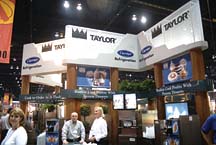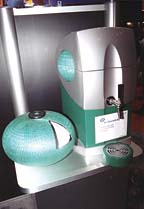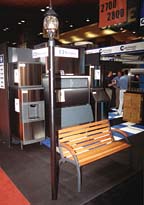
Here is a look at the latest in ice machine-related technology. (Coverage of freezers and coolers from the expo will be covered in the Aug. 4 issue of The News.)
Remote condensing ice machines (beyond the traditional approach as part of supermarket rack systems) were introduced to the industry several years ago.
Scotsman (www.scotsman-ice.com) became the most recent company to offer its version of the technology.
The company featured its Eclipse™ ice making method. The compressor, condenser, and receiver are located remotely in a move designed to reduce the discharge heat and noise associated with ice machines, especially when such machines are accessed by customers. The majority of the mechanicals are located on the building roof, in a two-piece modular design said to eliminate the need for a full-size crane to lift the pieces to the roof.
The compressor and condenser can be placed separately, said the company. Refrigerant lines are precharged, and quick connects eliminate the need for brazing on site. “By utilizing a pressure regulator valve, Eclipse technology ensures the compressor always operates within the manufacturer’s recommended operational envelope,” said the company.
Two ice makers and compressor units can be connected to a single, dual-circuit remote condenser. And a single Eclipse ice machine and compressor can be connected to a rack system.
Also new at Scotsman was a TouchFree icemaker/water dispenser, said to have a 25 percent reduction in fan noise. Among target locations are patient care facilities, food service areas, and laboratories. Various models produce nugget and flaked ice. The newest model, the MDT2C12, dispenses cubelet ice, which the company describes as a harder, slower melting form of ice. The newest model also has an infrared sensor that determines when to dispense ice, water, or both. “Since there is no physical contact with the surfaces of the machine, the risk of cross-contamination is dramatically reduced,” the company said.

The company also announced the expansion of a line of flaked ice makers. The F-1350M_H is a unit in the 1,300-pound production-per-day range; it includes the CleanCycle12 and a stainless steel dual-flight auger, designed to reduce stress on the unit.
AM Series under-counter ice makers create “top-hat” cubes, which are individually formed on the ice-making surface. The machine is designed for front air circulation. A flip-down door provides access to the ice bin. The water distribution system can be removed for cleaning, the company said. The series includes units with daily ice production of 50, 100, and 150 pounds.
Another recent addition to the Hoshizaki line is the KMD Series cube ice maker, with a target location on top of dispensers. The crescent cubes are shaped to allow beverages to be poured over them without the splash or waste sometimes caused by conventional cubes, said the company.
Manitowoc Food Service Group (www.manitowocice.com) showed a number of products in an exhibit area that included park benches and street signs.
Q-Model Series 1800 ice cube machines offers two cube sizes, dice and half-dice; the Q-Model Series 700/800 flake ice machine has a German-engineered stainless steel evaporator with wall thicknesses three times the industry standard; the Q-Model Series 320 ice cube machine has a stainless steel exterior “with the fit and finish of an appliance”; and the QPA-160 ice dispenser has a “push-for-ice” rocking chute dispense mechanism.
Another aspect of water filtration was addressed by Manitowoc’s ArcticPure™, which the company said has a built-in scale inhibitor, graded-density carbon block, and sanitary quick-change housing designed to minimize contamination of filter media during filter cartridge changeouts.
Manitowoc Beverage Equipment Inc. (www.manitowocbeverage.com) featured drop-in and freestanding ice chests from its Servend line. They are offered with and without cold plates.
IMI Cornelius (www.cornelius.com) showed a range of products. Its Draft Guard features a secondary regulator designed to automatically adjust pressure to temperature changes, to reduce service calls related to temperature changes. The Ultra Flow fast tap allows for the rapid filling of glasses or pitchers. And for those unwilling (or unable) to return kegs to the place of purchase the day after a party, the company was trial-ballooning nonreturnable kegs. The actual target market is small restaurants. The idea is based on the approach used in boxed wines. The beer is dispensed from a bag inside a plastic container. The air is compressed out of the bag, and the remaining beer takes up the remaining space in the bag.

The company also pointed out other aspects of its equipment designed to deal with issues such as hard water, food safety, and tight spaces. Also noted was equipment that has top air discharge, harvest assist (in which ice is pushed into the bin rather than waiting for gravity), and sea-salt-corrosion protection.
Kold-Draft (www.kold-draft.com) offered a couple of specialized aspects of ice equipment. It showed marine cubers made of stainless steel — including the fasteners — for corrosion resistance, with an enclosed water system to prevent water from splashing out of the machine or into the bin, and an optional marine manifold that provides individual shut-off valves for each water inlet and outlet along with a condenser by-pass valve to keep the cooling tower systems balanced in the event of a condenser blockage. A specially designed water circulation system is designed to control the effects of pitch and roll on the operation of the machine.
The company’s Prison Secure Ice System is designed specifically to meet the needs of correctional institutions. It has a “tamperproof, double-hinged outer door; double-clad, 16-gauge, heavy-duty stainless steel outer shell; and a locking, stainless steel lift-up, 16-gauge bin door.”
Taylor Company (info@taylor-company.com), part of a large exhibit space of Carrier Refrigeration, promoted what it called its “Electric Ice Program.” It consists of equipment for making frozen beverages.
For the transportation of ice, Follett (www.follettice.com) showed the Ice-DevIce™, a push cart on wheels with multiple small bins that can line up directly under an ice dispenser spout. In this way, the company said, ice can be moved from the machine to where it is needed in a safe and sanitary way.
Publication date: 07/07/2003




